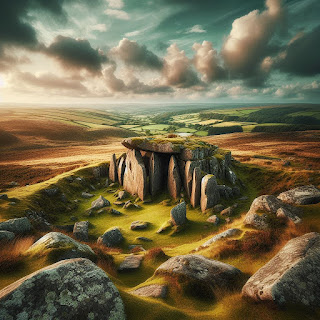The recent paper on Stonehenge Sarsen Debitage* ends with this conclusion:
"Our key message is that studies attempting to use surficial (pXRF) analysis to provenance any excavated artefact must demonstrate that weathering processes following burial did not significantly alter the primary chemical signature of the material before any meaningful provenance interpretations can be made."... "Any future attempts to provenance excavated dolerite fragments at the monument (likely derived from the in situ dressing of megaliths and/or the removal of flakes in more recent history) must consider differences in the weathering regime experienced by the buried fragments, exposed potential outcrops and standing stones. Due to its mineralogical composition, dolerite is more susceptible to chemical weathering than sarsen. Thus, one should expect differences in weathering to be much more significant between buried dolerite fragments exposed to subsoil weathering, and dolerite outcrops and megaliths exposed to differing intensities and durations of subaerial weathering."
This obviously could be thought to apply to the existing analysis of the bluestone dolerites, and any other non-sarsen stone.
So is there a problem?
Firstly, apart from the Newall boulder (https://www.sarsen.org/2023/07/the-erratic-that-came-in-from-cold.html), all the pXRF analysis has been on exposed Stonehenge stones comparing to exposed Welsh rocks, so they are like for like comparisons. And the Newall boulder was further analysed to show it was part of a broken monolith from Craig Rhos‐y‐Felin**
Secondly the geochemistry revealed by xPDF is only part of the story. The recent Ixer, Bevins et al papers have also used petrology, understanding the matrix of the rock, to identify sources.
For instance in Bevins, Richard & Ixer, Robert & Webb, Peter & Watson, John. (2012). Provenancing the rhyolitic and dacitic components of the Stonehenge landscape bluestone lithology: New petrographical and geochemical evidence. Journal of Archaeological Science. 39. 1005–1019. 10.1016/j.jas.2011.11.020 the authors showed how Craig Rhos‐y‐Felin rhyolite had been misidentified as microtonalite, the geochemistry was very similar but the petrography different. This holistic approach to identification instills confidence.
But the big difference is in the nature of the stones. Sarsen is over 99% silica, it is the white Wonderloaf of rocks. The various bluestones are complex rocks with other compounds in great abundance in them. So the presence of a small amount of chemical changes from weathering is important on Sarsen but not for bluestone. As Rob Ixer says; "A smear of marmite on plain buttered toast would be tasted but the same smear on jalapeno-anchovy toast would add nothing."
So the valuable lesson of the problems of using pXRF on Sarsen for sourcing studies doesn't cause worries about the reliability of the recent Bluestone papers, and is unlikely to be a problem in the future.
T. Jake R. Ciborowski, David J. Nash, Timothy Darvill, Ben Chan, Mike Parker Pearson, Rebecca Pullen, Colin Richards, Hugo Anderson-Whymark,
Journal of Archaeological Science: Reports, Volume 53, 2024, 104406, ISSN 2352-409X,
https://doi.org/10.1016/j.jasrep.2024.104406.(https://www.sciencedirect.com/science/article/pii/S2352409X24000348)
Richard Bevins Rob Ixer Nick Pearce James Scourse Tim Daw
https://onlinelibrary.wiley.com/share/author/YUUAUVRWBNTZTPSQVBGM?target=10.1002/gea.21971

















